It’s hard to believe it’s been almost nine months since Nvidia unveiled their first Ampere graphics card, the GeForce RTX 3080. Though I suppose it might also have felt like an eternity for those of you who have been trying to buy one for the past nine months.
The RTX 3080 was a truly exciting product, offering 20% better performance over the much more expensive RTX 2080 Ti ($900 vs $1,500). Although many were lucky enough to grab one, it was always hard to get, and once the cryptomining boom hit again, tracking one down at the MSRP has been virtually impossible.
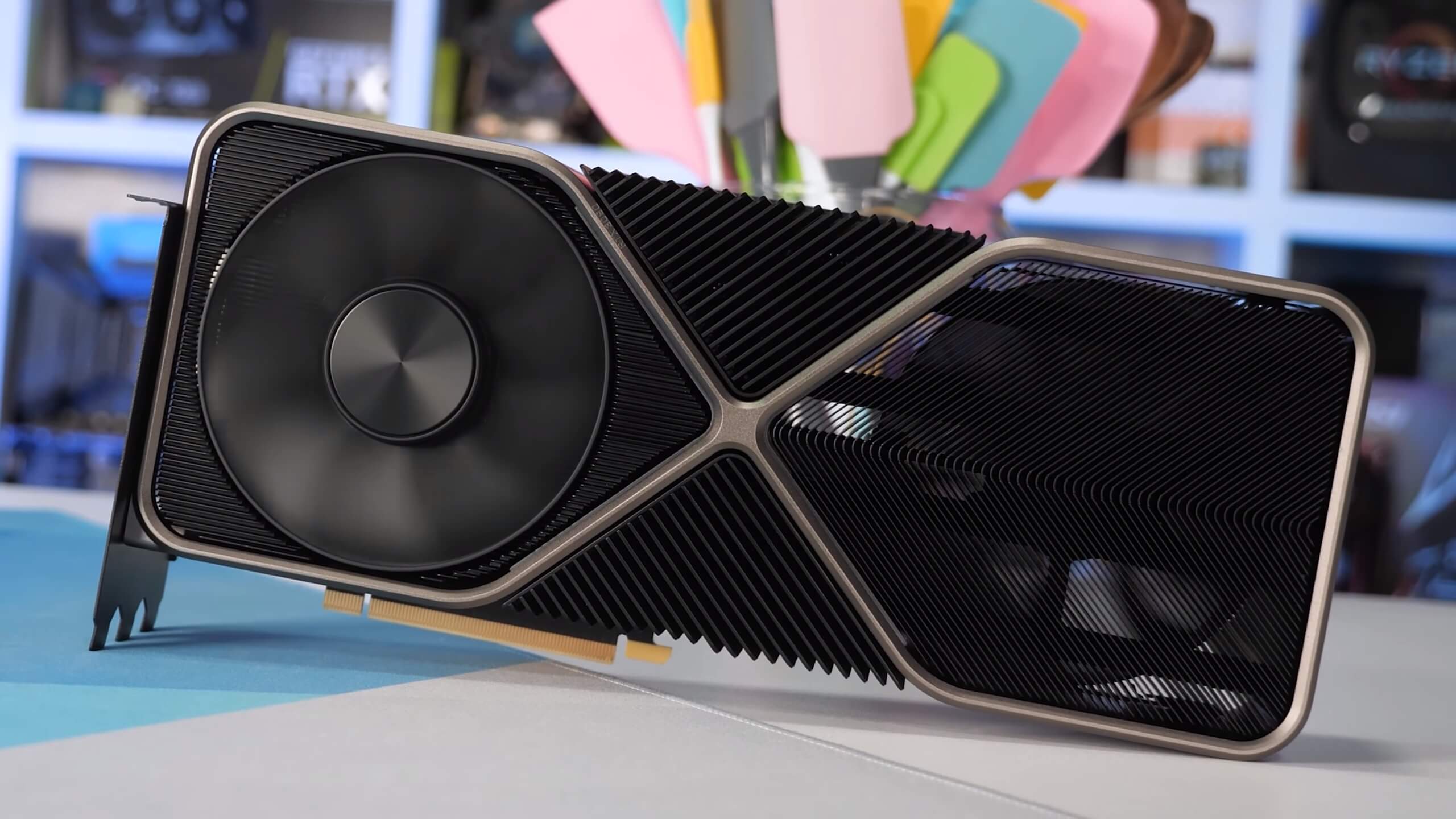
Over the course of the following weeks and months we’ve also received the fully unlocked version of the GA102 silicon called the RTX 3090 (which costs a cool $2,000 MSRP) — though that one never made much sense for gamers — the RTX 3070, which is based on a nearly 40% smaller GA104 die, meaning it’s possible for Nvidia to get more of these dies out of a wafer. Also sharing the GA104 die is the RTX 3060 Ti, probably the hardest to find of all the Ampere-based graphics cards since Nvidia has been prioritising the higher margin RTX 3070 thanks to seemingly strong yields.
Then most recently we saw the launch of the GeForce RTX 3060, based on the 300mm2 GA106 die. It’s meant to cost $420, but of course you can’t buy it, and you certainly can’t get one for anywhere near the MSRP.
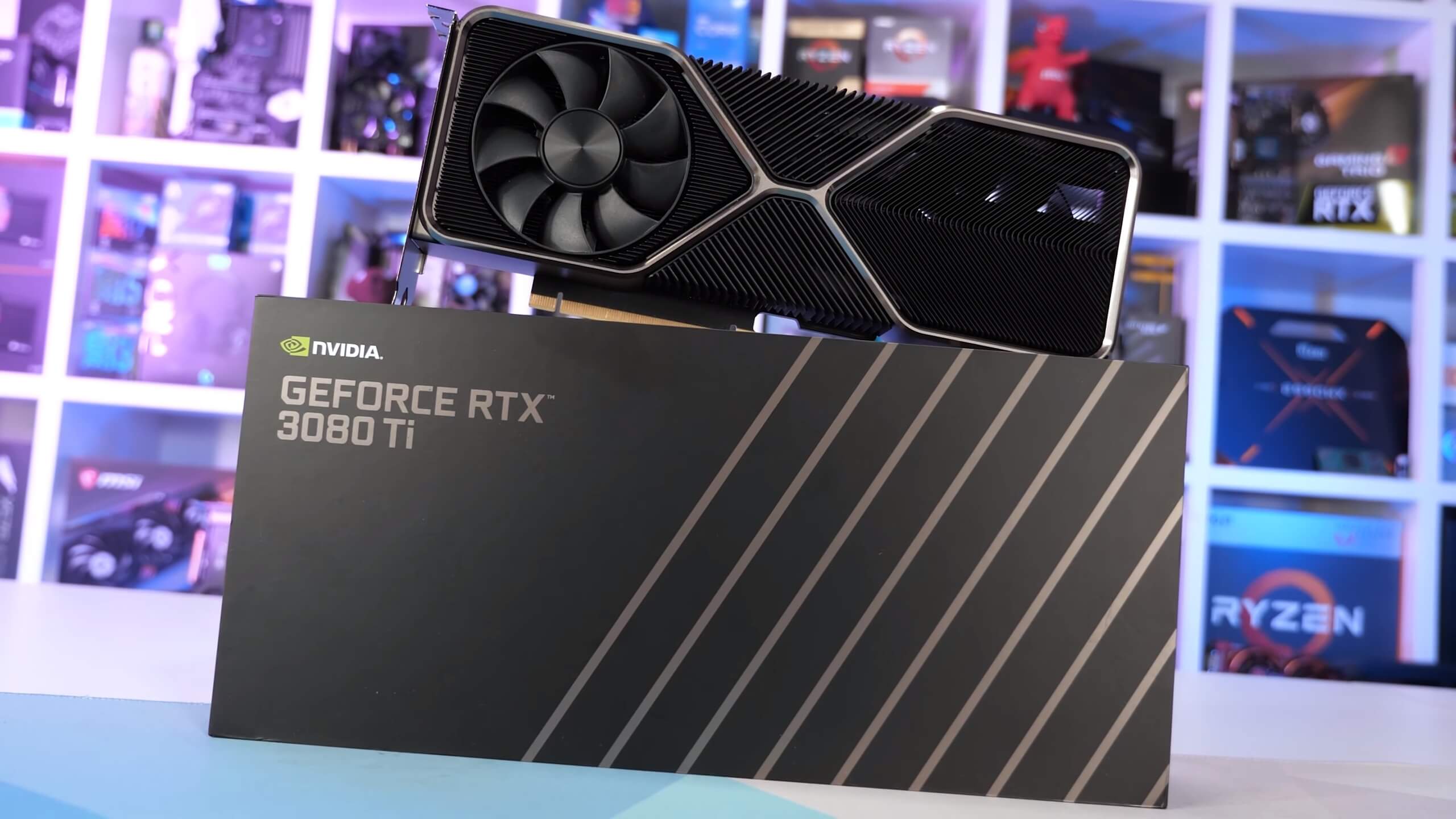
So here we are, gamers still can’t buy a graphics card in mid-2021, or at least not easily and pricing remains sky high. Ideally we’d like to see AMD and Nvidia release sub-$400 GPUs — hello GTX 1650! … shrugs — to somewhat alleviate the supply issues and give gamers a better chance of buying a graphics card at a more reasonable price. But instead, Nvidia is refreshing GA102 with the GeForce RTX 3080 Ti, which is a new expensive GPU that guess what, you may still won’t be able to buy.
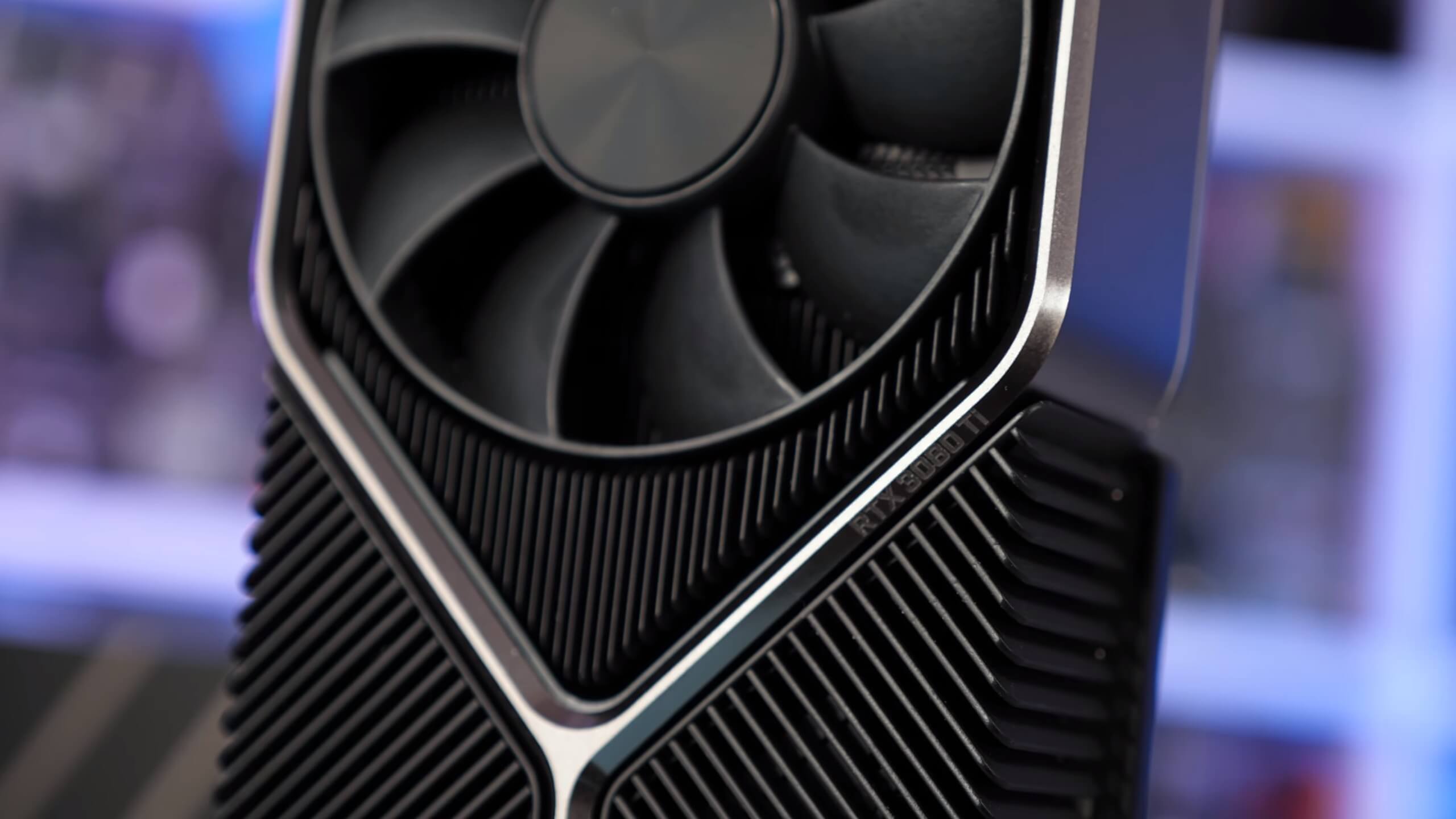
The reasoning for this is simple, Nvidia aims to make more money as long as this GPU boom lasts. Now, if you don’t believe Nvidia is selling GPUs directly to miners, which happens to be our opinion, then it’s AIBs and/or distributors who are selling to miners in volume. It must be great to be selling all those RTX 3090, but letting go of slightly defective GA102 silicon for less than half the price probably stings a lot right now.
That’s exactly where the RTX 3080 Ti comes in, allowing them to maximise profits of silicon that’s not quite good enough to be an RTX 3090. Rather than selling a good portion of that silicon as a “$900″ product, they can now extend the profit margin by roughly 70%. Yes, the MSRP of the RTX 3080 Ti is $1,920.
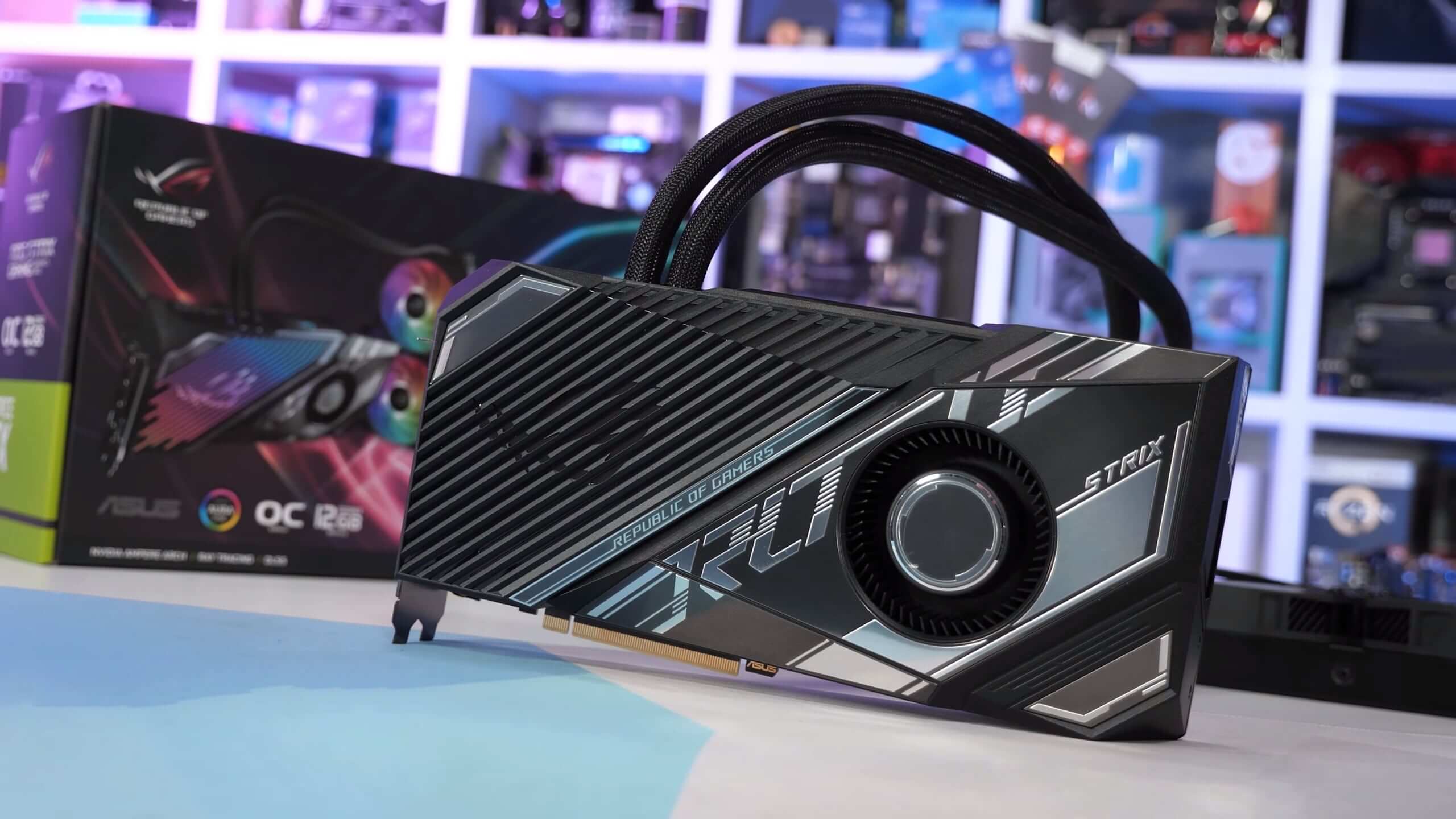
For the effort, Nvidia is throwing in an extra 2GB of VRAM, an 18% increase in cores, and the wider 384-bit memory bus. Essentially you have an RTX 3090 with half the VRAM since we’re talking about ~2.5% fewer cores than the 3090 flagship.
Even at 4K, the RTX 3090 was on average just 13% faster than the original RTX 3080, so you can expect the 3080 Ti to be very similar to the 3090 in terms of performance and possibly ~10% faster than the 3080. That makes the 3080 Ti as pointless as the 3090 for gamers, given at the MSRP it should cost a little over 70% more than the 3080, for maybe 10% more performance, or well beyond the point of diminishing returns.
That’s probably not a great way to start this review, but there’s no mystery to uncover here. Sometimes with these refreshes we get an odd mix of core and memory configurations, but in this instance the 3080 Ti has basically the same memory subsystem as the 3090 with a few less cores.
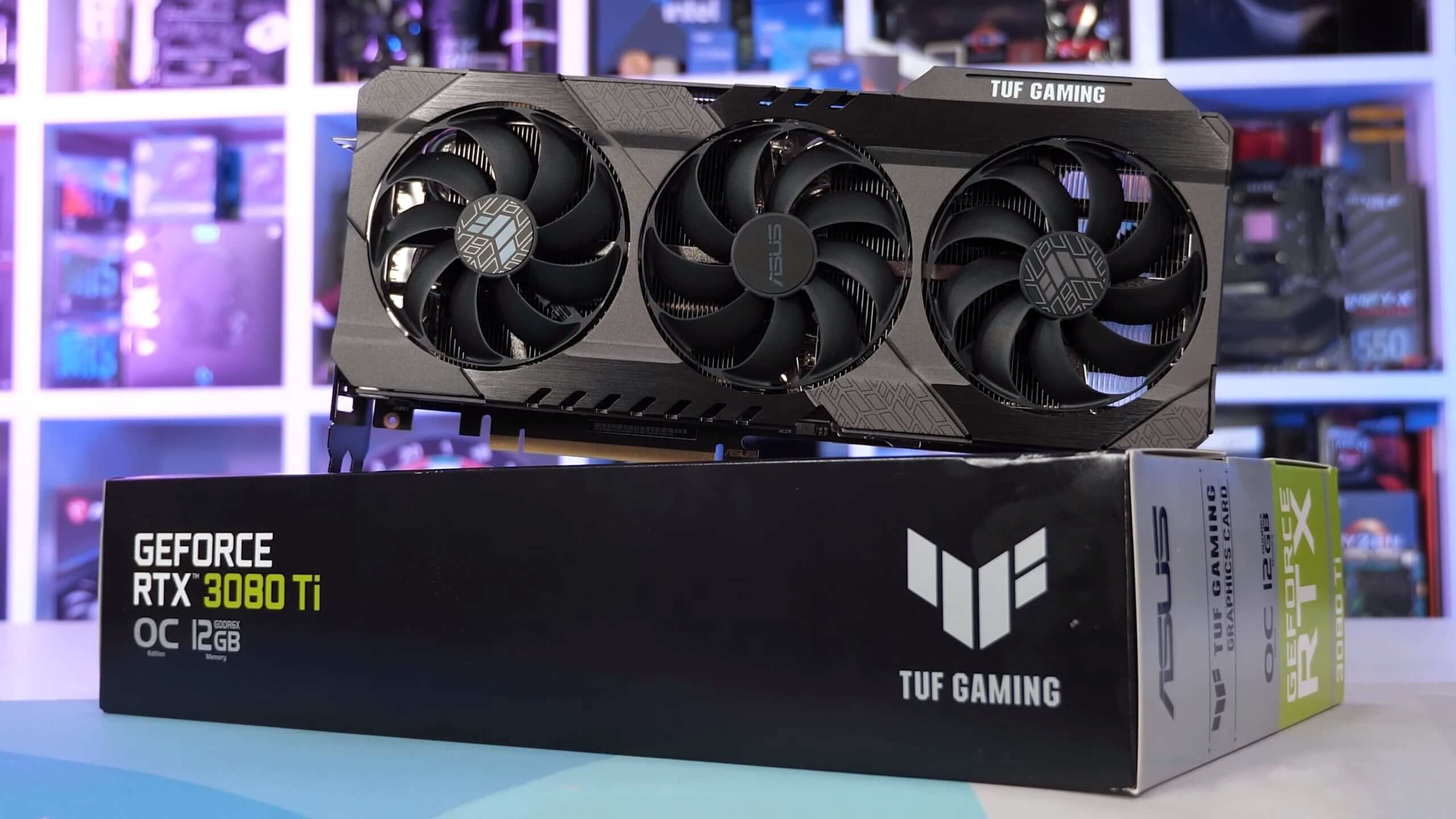
With that said, let’s go over a few benchmarks using the Founders Edition RTX 3080 Ti card. Please note all benchmark results are based on AMD and Nvidia GPUs running at the official specification, so no factory overclocking. In total, we’ve tested 12 games at 1080p, 1440p and 4K. We’ve also got power, overclocking and ray tracing data to go over.
It’s also worth noting that all this data is fresh, after weeks upon weeks of testing we have all our benchmark data updated on the new Ryzen 9 5950X testbed, which has been configured with 32GB of dual-rank, dual-channel DDR4-3200 CL14 memory. Let’s get into the results…
Benchmarks
First up is Death Stranding at 1080p, here the 3080 Ti delivers 3090-like performance — we’re talking a 1-2 fps margin — and that means the 3080 Ti is 4% faster than the 3080 but slower than the 6800 XT and 6900 XT.
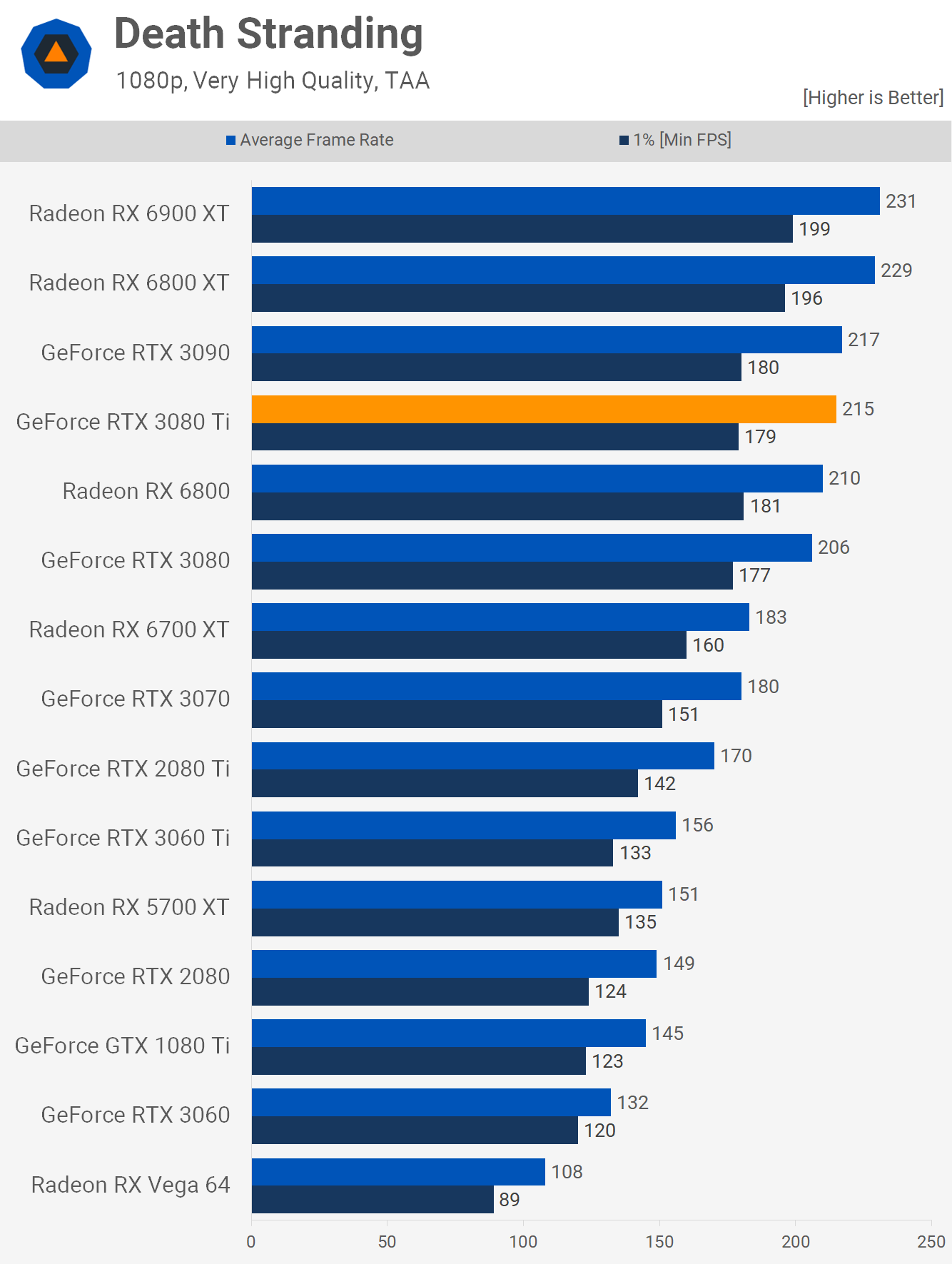
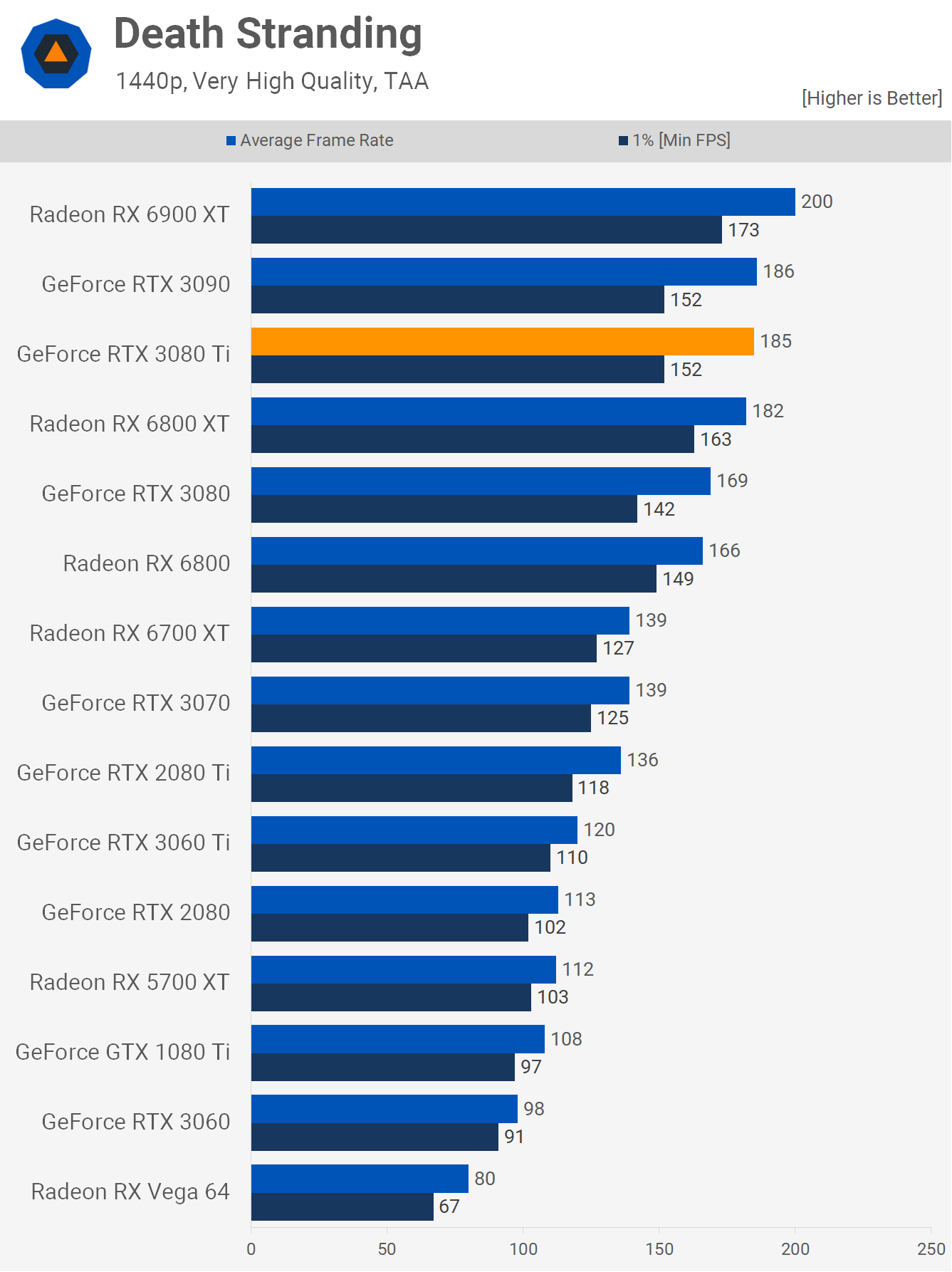
Increasing the resolution to 1440p allows the 3080 Ti to match the 6800 XT, while it was again delivering 3090-like performance. This also sees it beat the 3080 by a 9% margin.
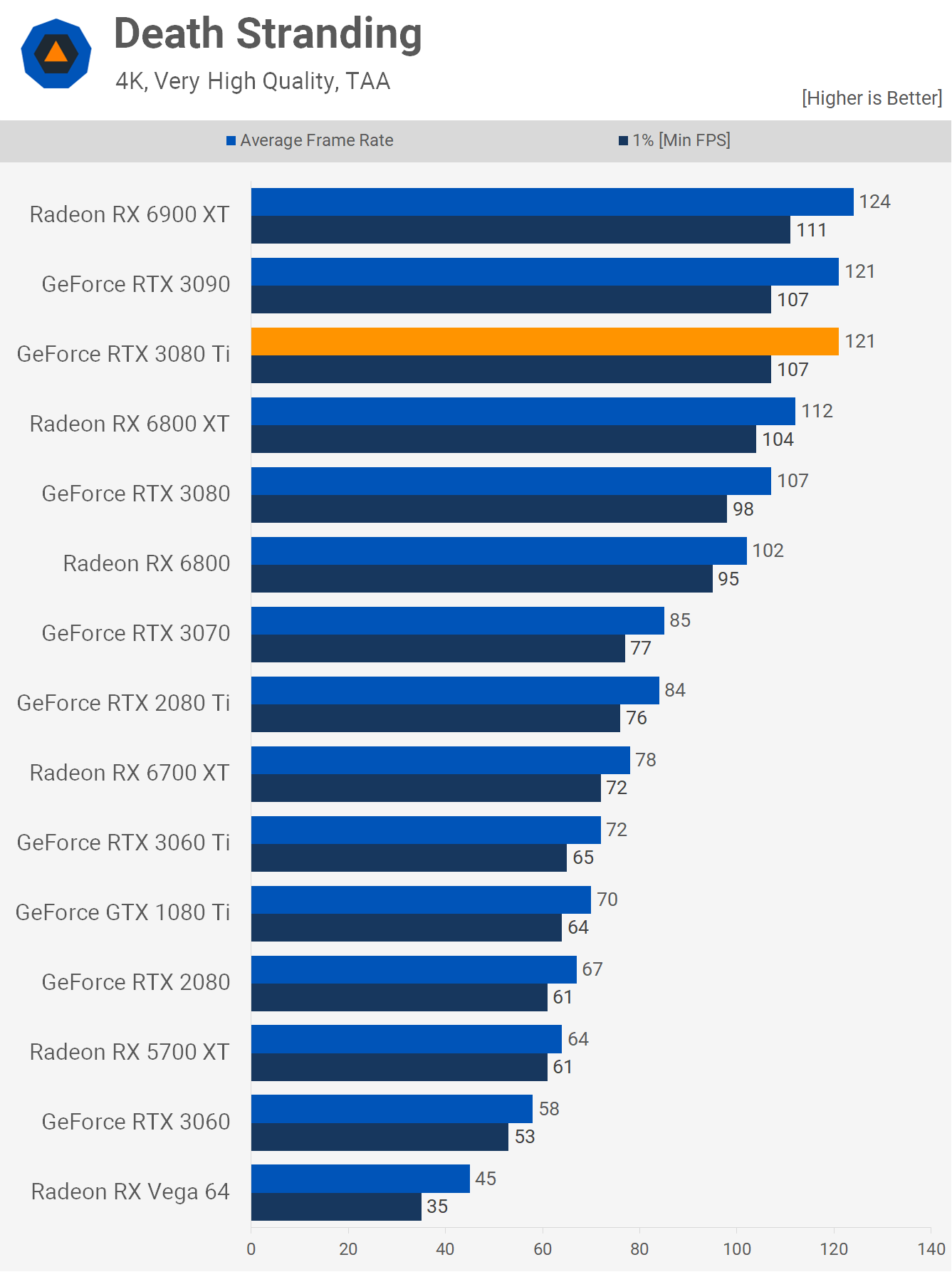
At 4K, the 3080 Ti matches the 3090 exactly with 121 fps on average, making it just 2.5% slower than the 6900 XT. It was also 13% faster than the RTX 3080.
Moving on to Watch Dogs Legion we find more of the same: that is to say the RTX 3080 Ti is an RTX 3090 with half the VRAM.
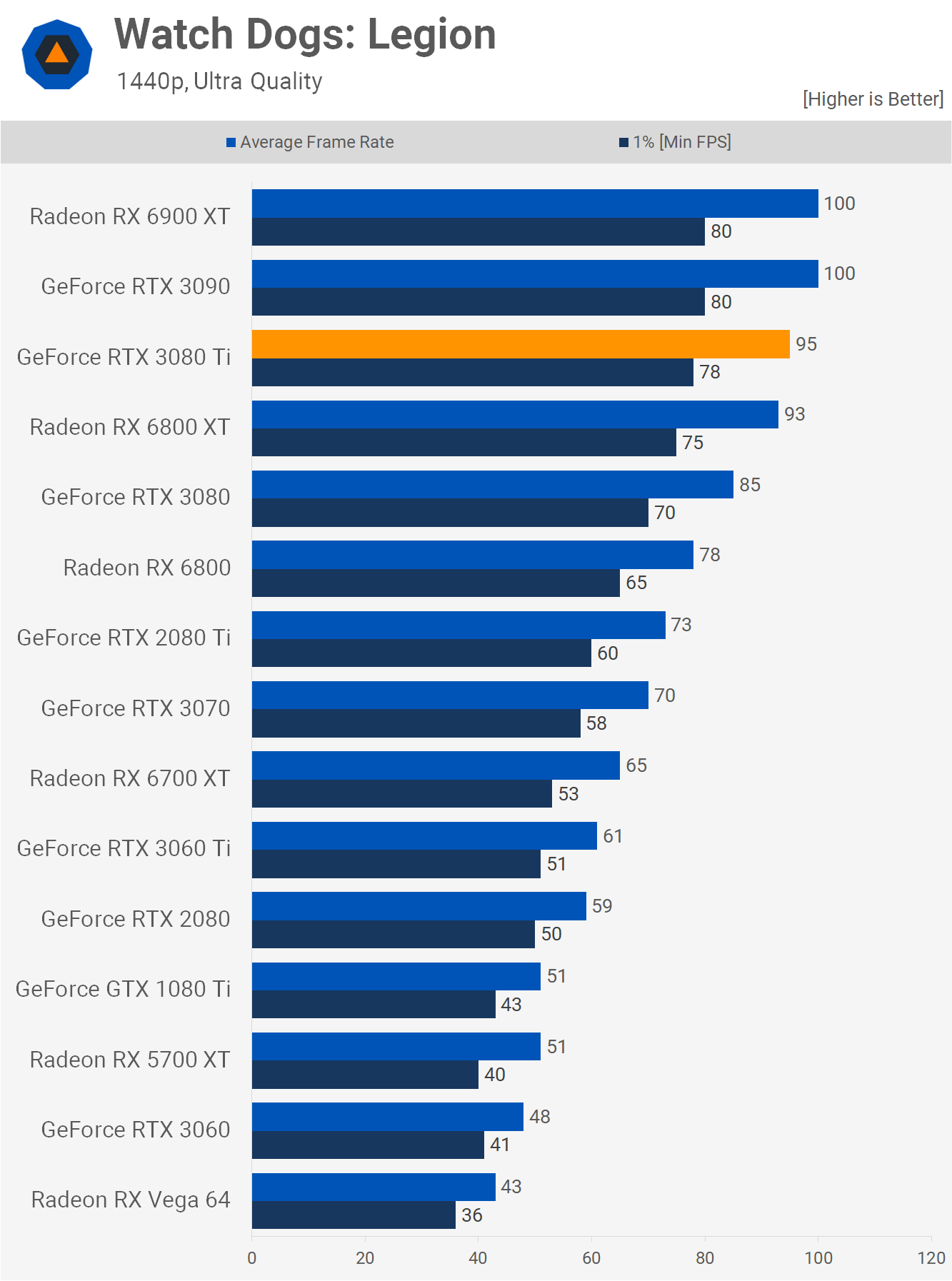
The 3080 Ti did slip behind the RTX 3090 at 1440p, though the margin was small and some 12% faster than the 3080.
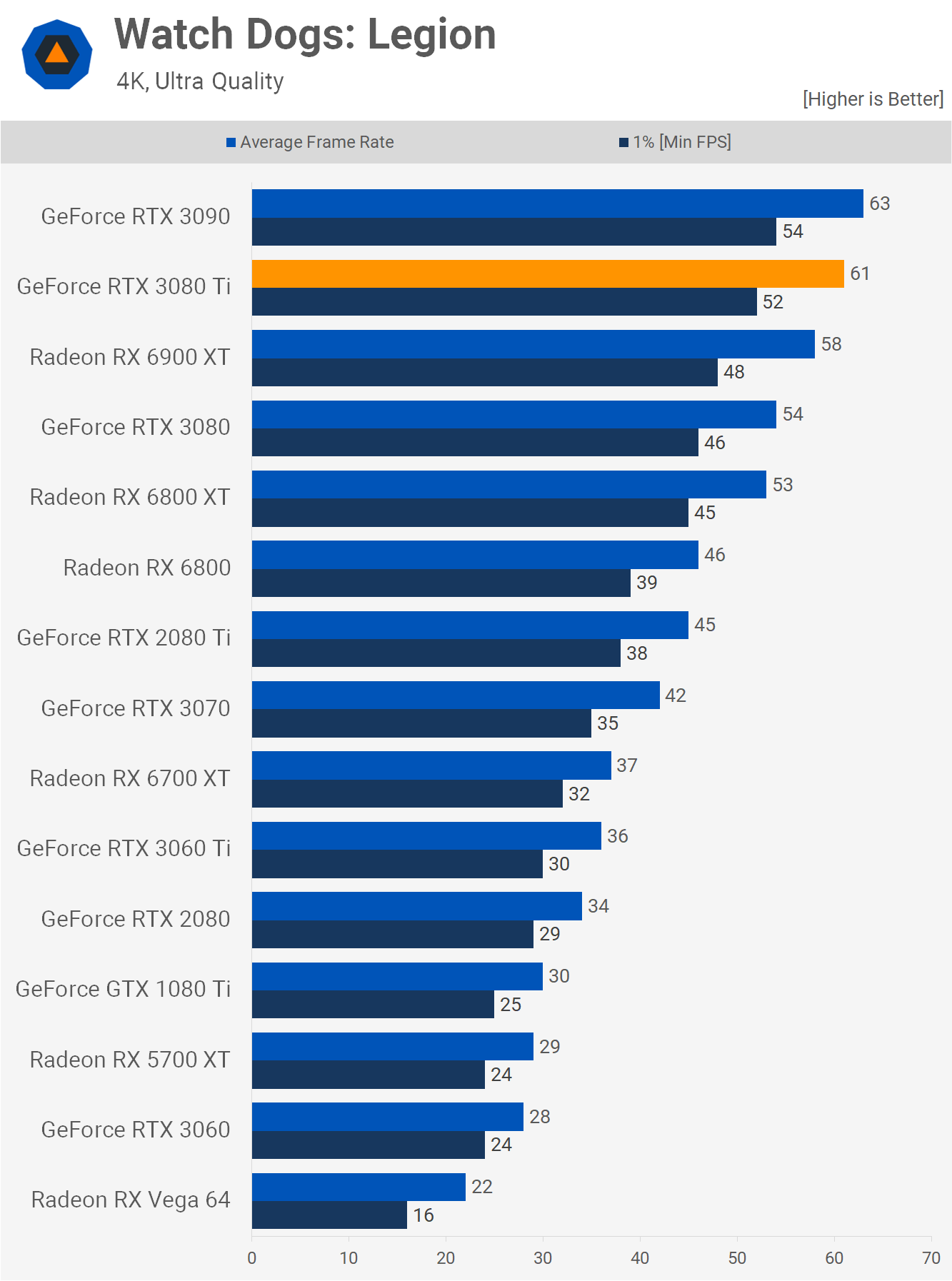
At 4K the 3080 Ti is 3% slower than the RTX 3090 and 13% faster than the 3080, making it 5% faster than the Radeon RX 6900 XT. Of course, in a normal market if you cared about value you’d get either the 6800 XT or RTX 3080.
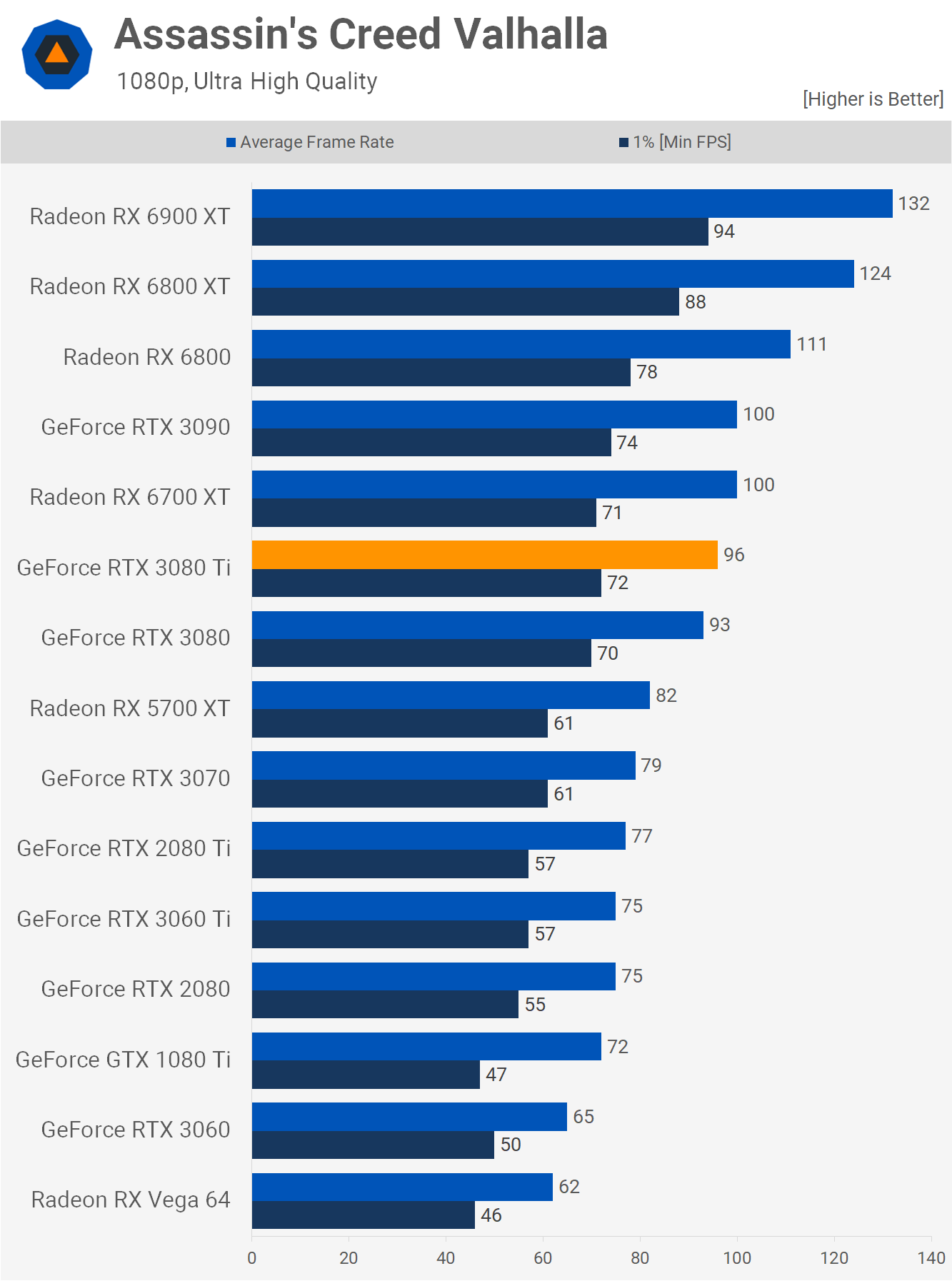
Next we have Assassin’s Creed Valhalla, here we’re looking at 96 fps on average at 1080p using the maximum in-game quality settings. This meant the 3080 Ti was just 4% slower than the RTX 3090 and 3% faster than the RTX 3080.
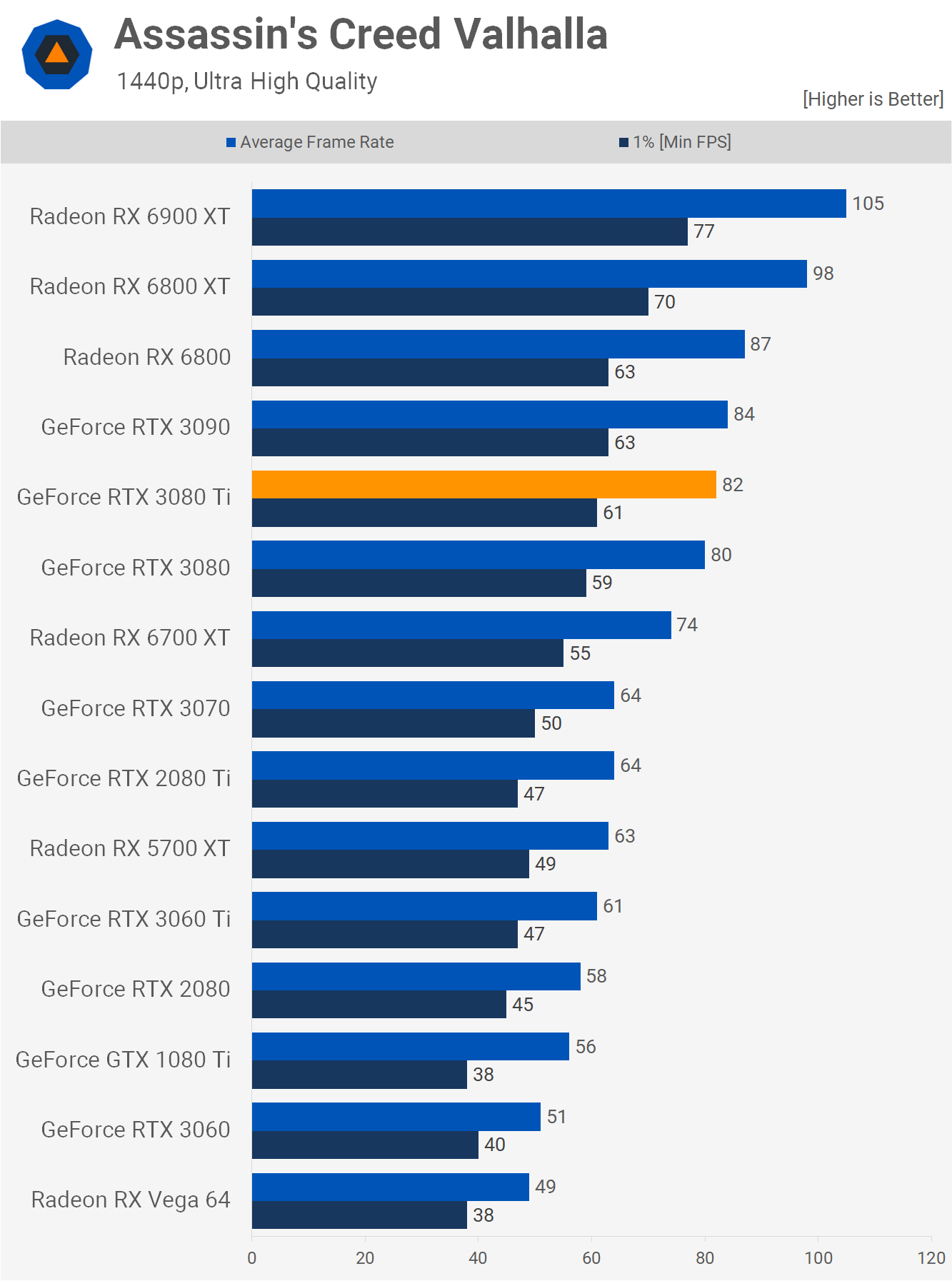
At 1440p it slots right between the 3080 and 3090 with 82 fps. It’s worth noting that while Watch Dogs Legion is an Nvidia sponsored title, Assassin’s Creed Valhalla is AMD sponsored. The Radeon GPUs enjoy of a big performance advantage in this game, for example, the 6900 XT is a massive 28% faster than the 3080 Ti.
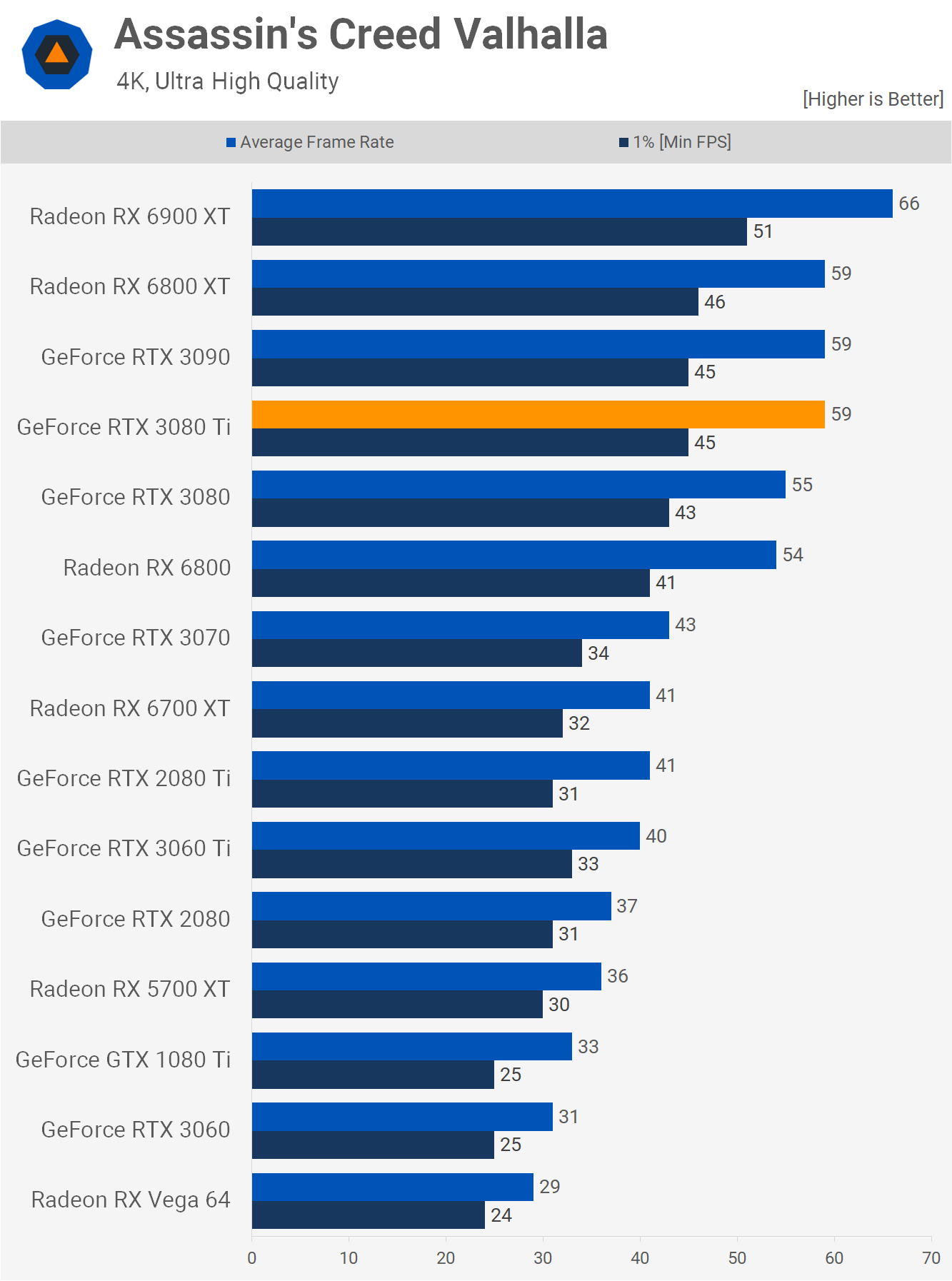
Moving up to 4K sees the RTX 3080 Ti average 59 fps, allowing it to match the RTX 3090 and 6800 XT, though it was still 11% slower than the 6900 XT. Moreover, when compared to the RTX 3080 we’re looking at a mere 7% performance increase.
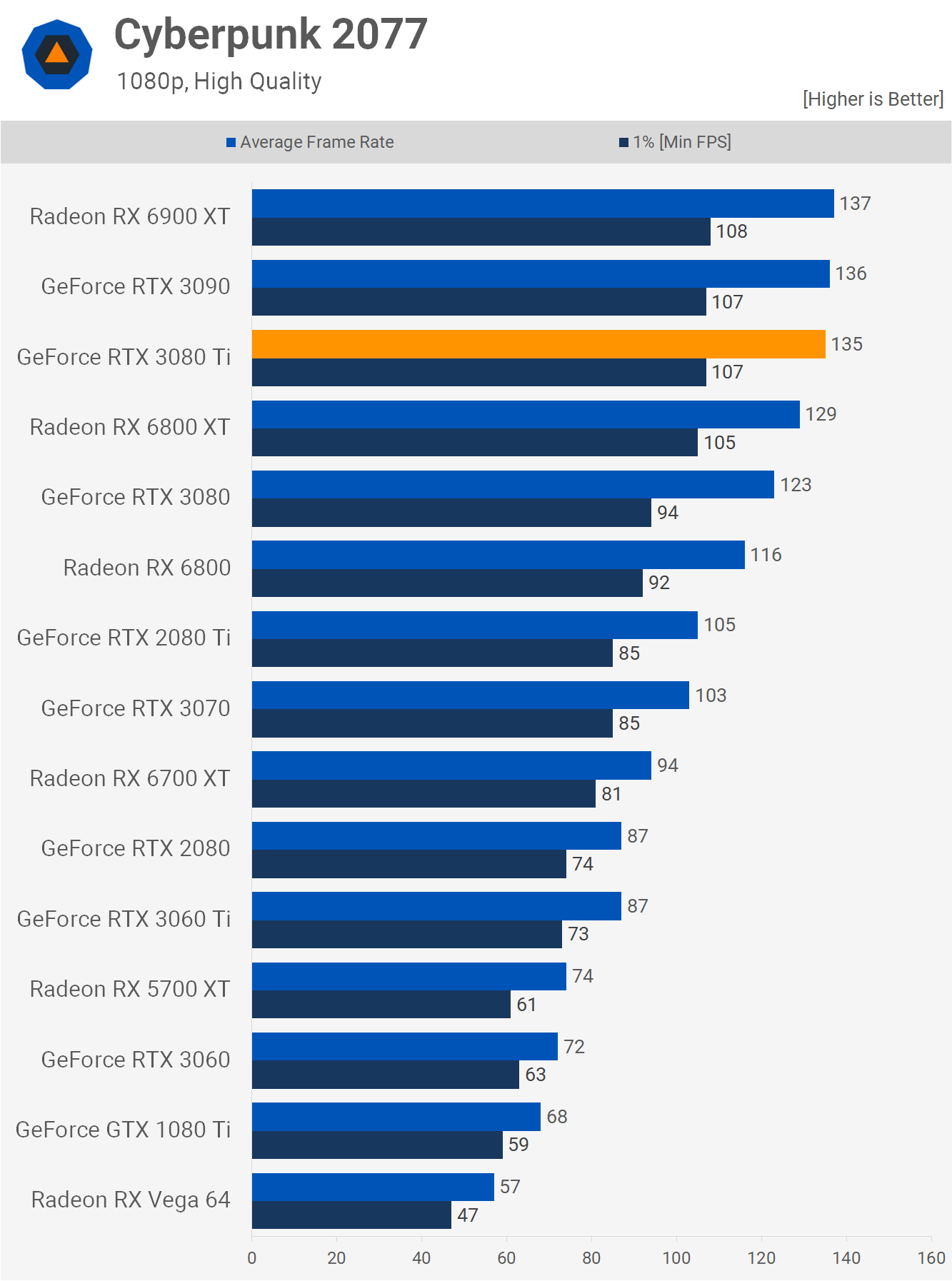
In Cyberpunk 2077 running at 1080p we’re looking at comparable performance between the 3080 Ti, 3090 and 6900 XT. The 3080 Ti is 10% faster than the original 3080.
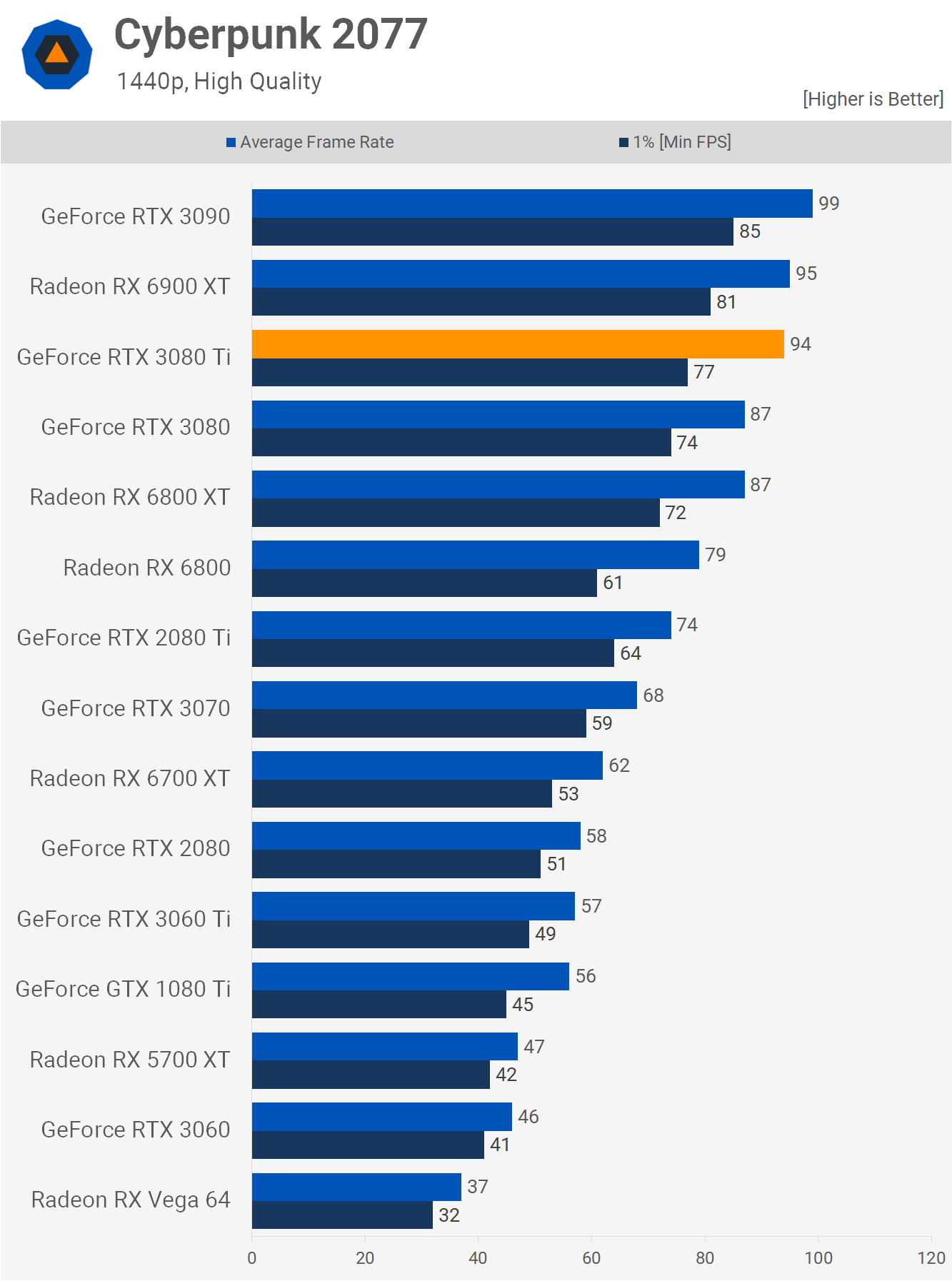
Then at 1440p the new 3080 Ti is 8% faster than the vanilla 3080 and 5% slower than the 3090, we’re also looking at comparable performance with the 6900 XT.
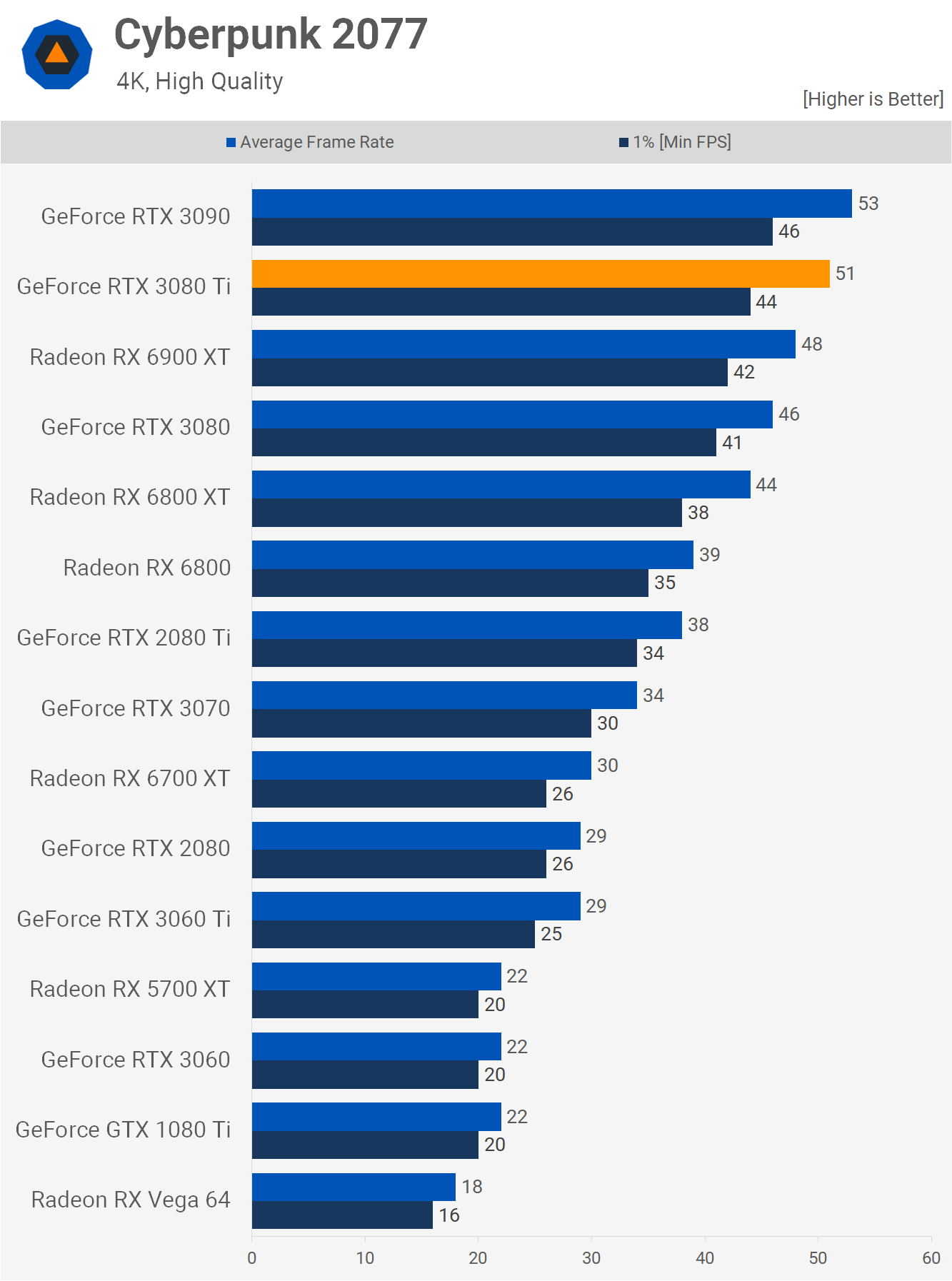
Finally, at 4K the 3080 Ti was just 4% slower than the 3090 and 11% faster than the 3080 and 6% faster than the 6900 XT. So similar margins to what we’ve seen in the previous 3 titles, so let’s move on to look at the 12 game average.
Average Performance
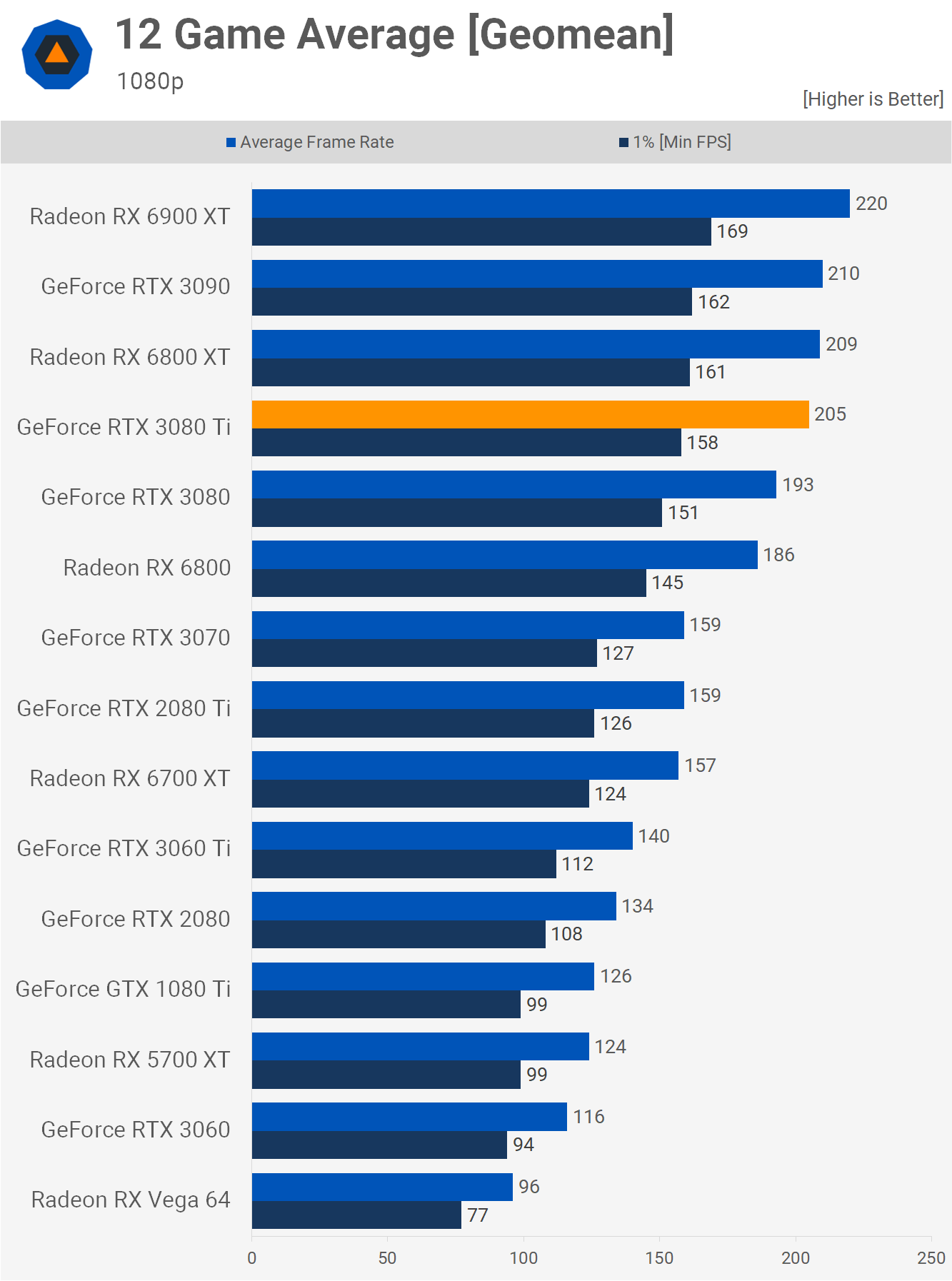
Across the 12 games we tested at 1080p, the GeForce RTX 3080 Ti is… wait for it, fundamentally an RTX 3090 with half the VRAM. We’re talking about 2% slower on average and just 6% faster than the RTX 3080. For those seeking maximum performance for low resolution competitive gaming the 6900 XT is slightly faster, offering 7% more performance on average.
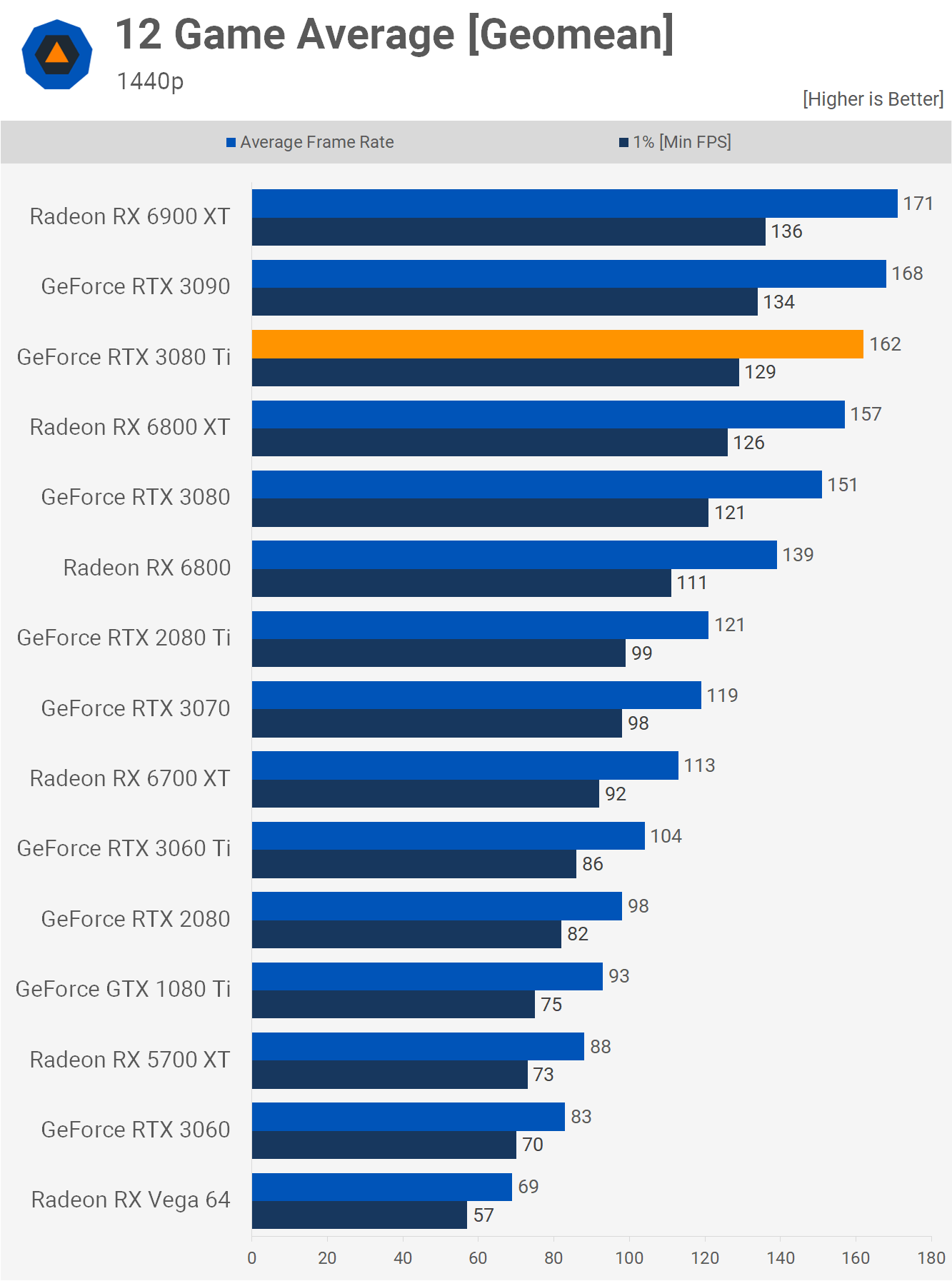
At 1440p the margins grow a little, here the 3080 Ti is 4% slower than the 3090. That said, it’s now only 5% slower than the 6900 XT, but overall for rasterization performance the Radeon GPU was a little faster in our dozen game sample while offering more VRAM.
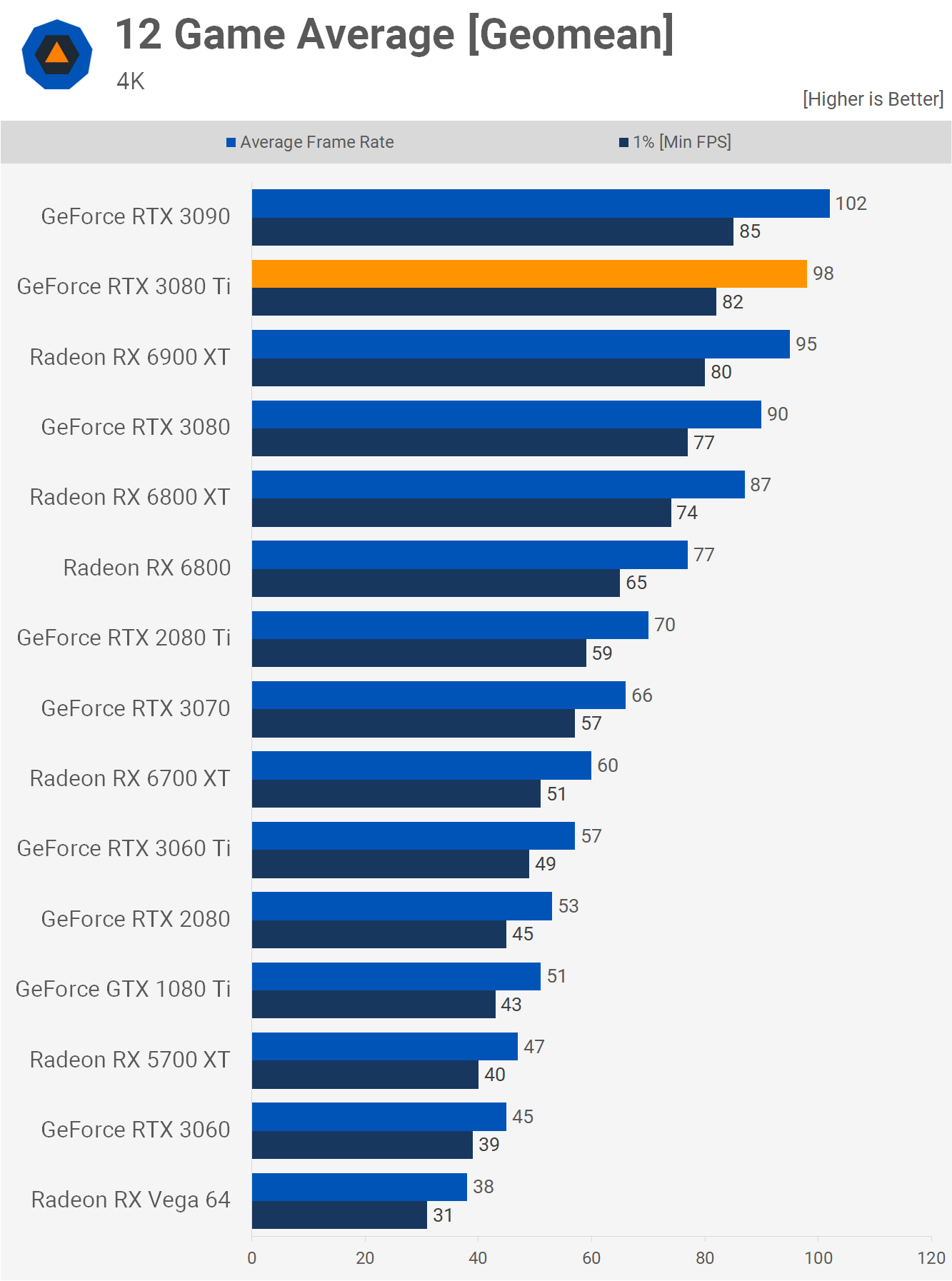
At 4K, the 3080 Ti is able to beat the 6900 XT by a slim 3% margin. It’s 4% slower than the RTX 3090 and 9% faster than the RTX 3080.
Power Consumption
For testing power consumption, we’re going to focus on the total system results and put the Nvidia PCAT testing on hold as we’d like to investigate further on some claims regarding task scheduling.
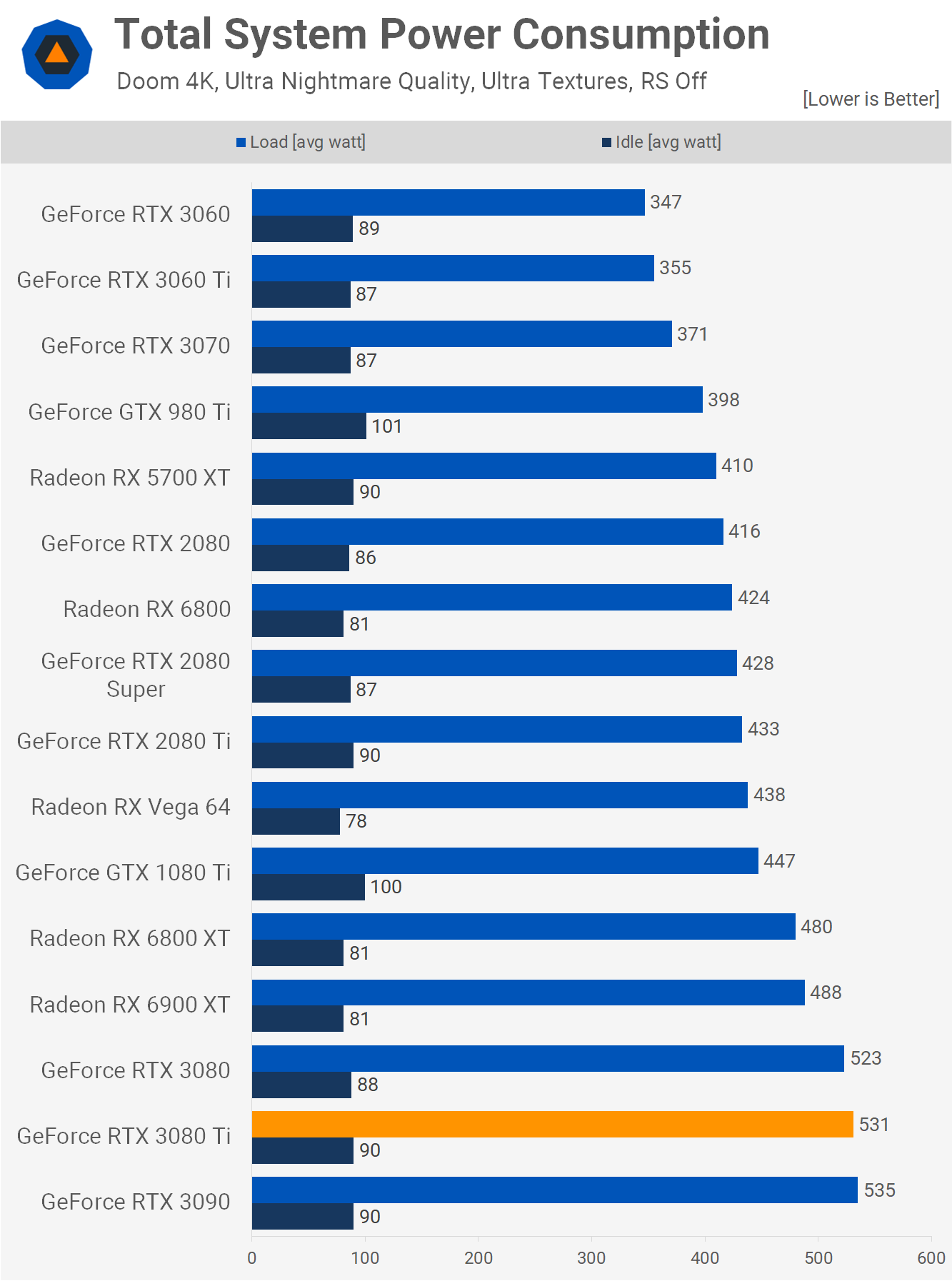
Here’s a look at power consumption in Doom and as you can see the 3080 Ti is very similar to the 3080 and 3090, slotting in between the two. In this example, the 3080 Ti was on average 6% faster than the 6900 XT, but pushed total system usage 9% higher, so RDNA2 is slightly more efficient, though overall it’s going to make very little difference to gamers.
AIB Cards: Asus and MSI
We have a few AIB cards on hand, so we’ll take a look at those and do some quick overclocking. Nvidia Founders Edition model appears to have borrowed the cooler from the RTX 3080 as they appear physically identical. Whereas the 3080 featured a total board power of 320 watts, the 3080 Ti jumps up to 350 watts, for a 9% increase.
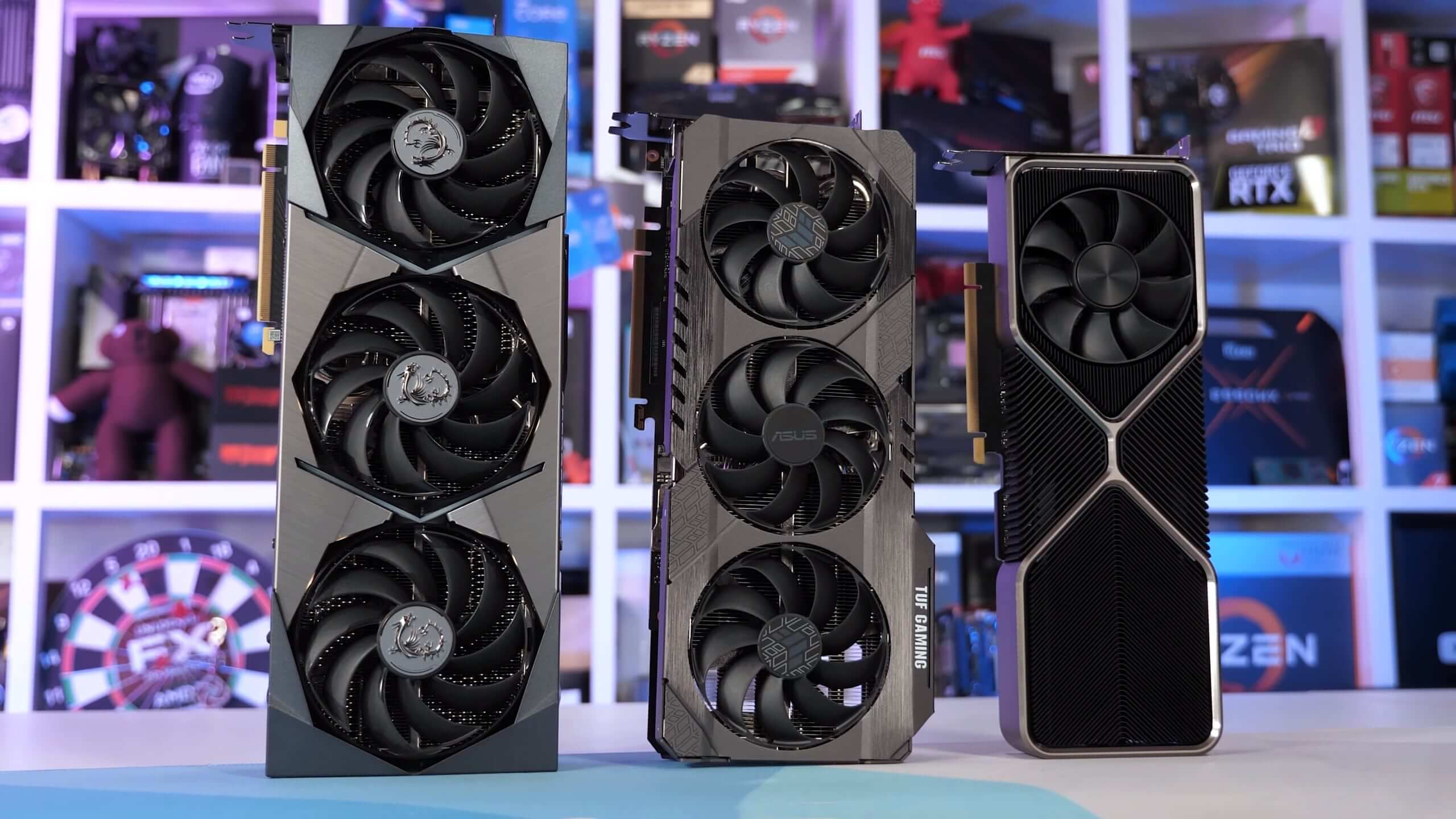
This increased power saw the peak operating temperature rise by 2C to 77C and the fan speed by 200 RPM to 2100 RPM, so as far as user experience is concerned, they’re about the same. Under these conditions the FE model averaged a core clock speed of 1770 MHz, which is well above the advertised GPU boost clock, but that’s how Nvidia’s GPU boost works. It’s an impressive result for a dual-slot graphics card, so bear that in mind as we take a look at the much larger AIB models.
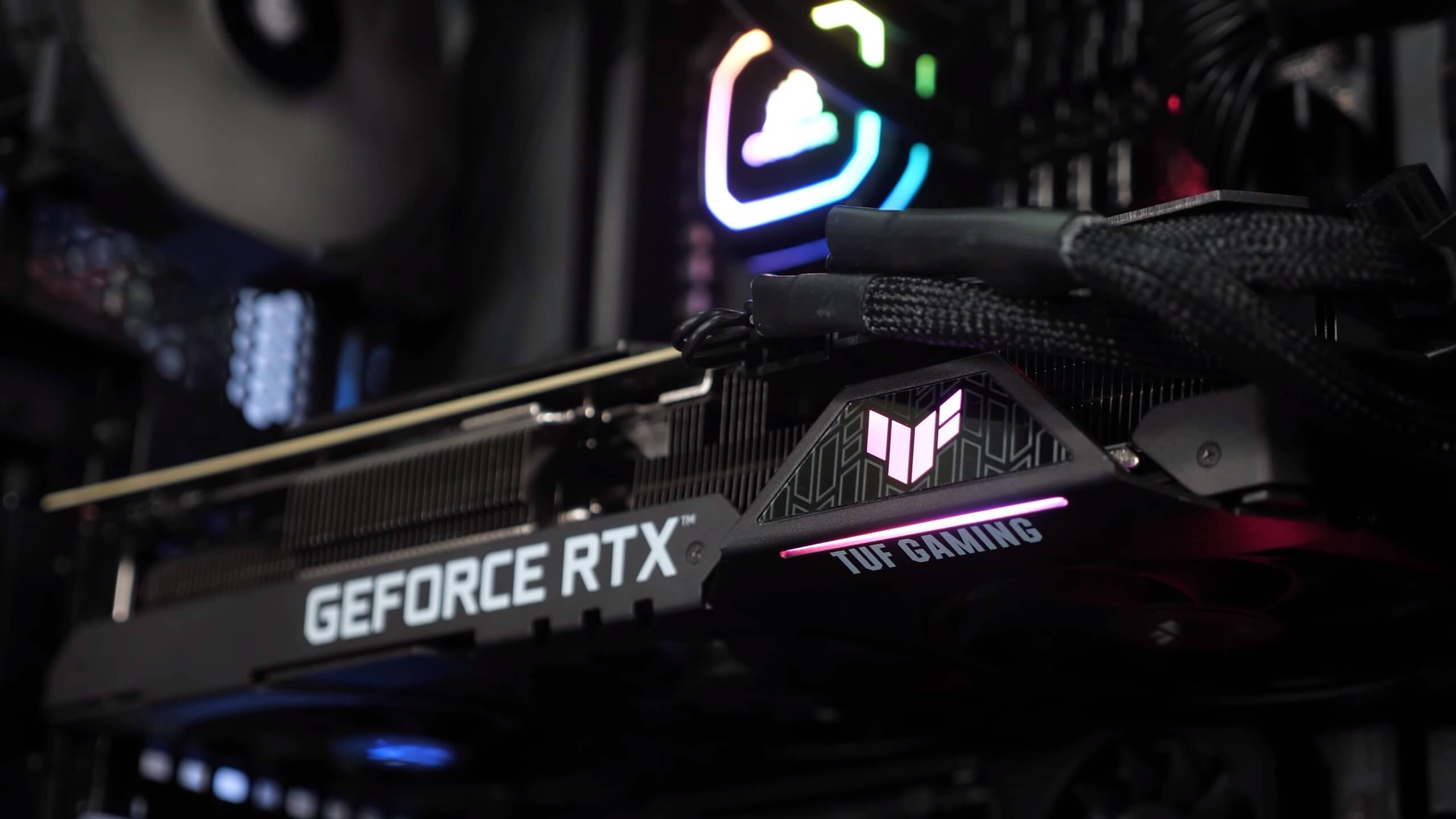
The Asus RTX 3080 Ti TUF Gaming is a copy of the original 3080 TUF Gaming, and that’s a good thing as that model was excellent. The new 3080 Ti version works remarkably well, peaking at just 64C in our stress test with a fan speed of 2000 RPM, and here it averaged a core clock speed of 1830 MHz.
Asus also sent over their new ROG Strix LC RTX 3080 Ti OC, which is another impressive graphics card. Last year we checked out the ROG Strix LC version of the 6800 XT, which worked very well, and the only real criticism was the mess of cables that ran from the radiator to the graphics card. Thankfully Asus took note and has now sleeved all those cables with the liquid cooling tubes for a much neater package.
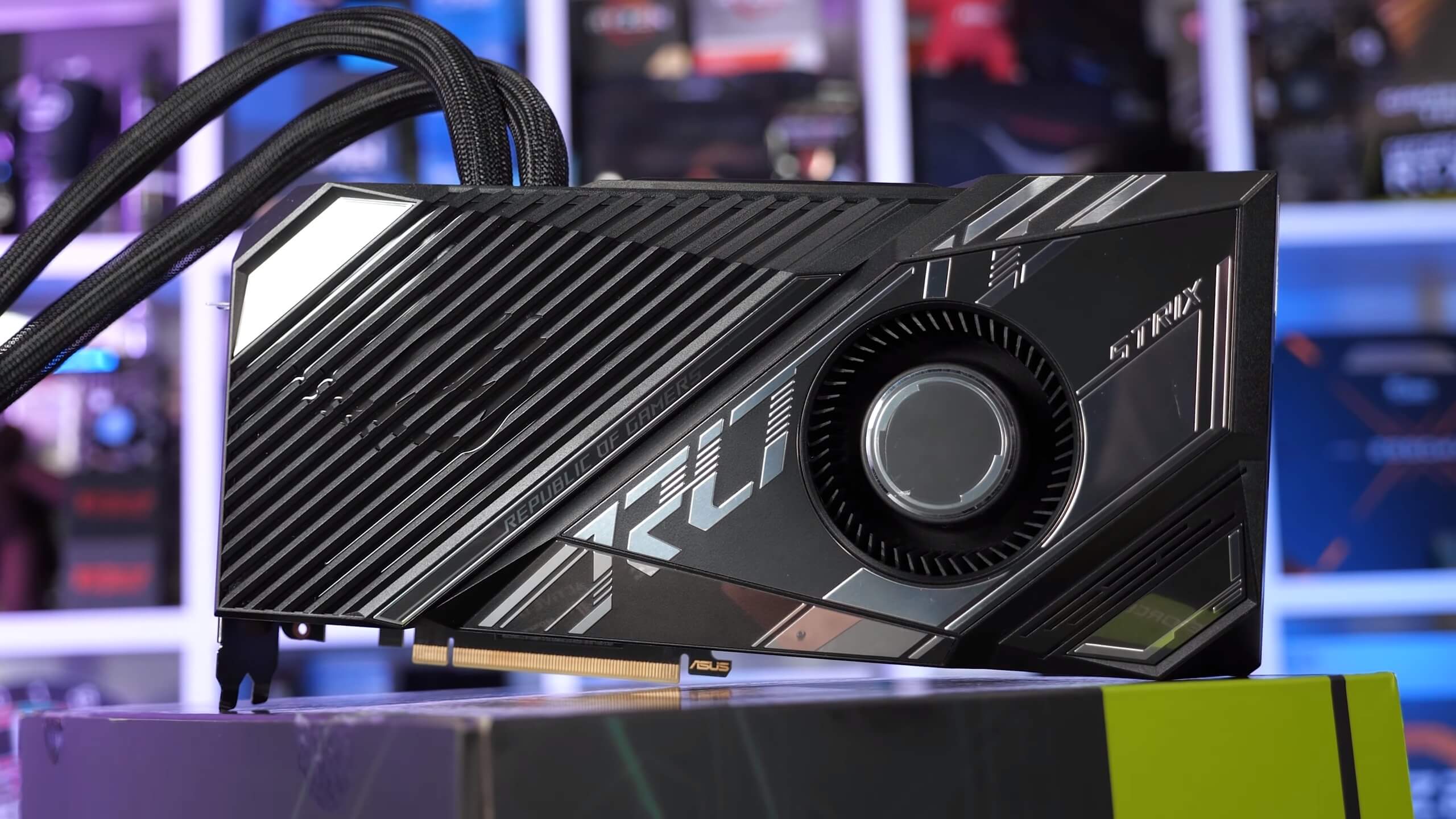
Out of the box this model peaked at 49C with a fan speed of just 1500 RPM, which allowed for an average clock speed of 1920 MHz, or a 5% increase over the TUF Gaming, while running 15C cooler and quieter. Of course, this premium model will be much more expensive, but that’s just par for the course when discussing liquid-cooled graphics cards.
Then there’s the MSI RTX 3080 Ti Suprim X, a gigantic air-cooled graphics card. To give you an idea of just how big and heavy this thing is, the Founders Edition model weighs 1365 grams and the TUF Gaming 1400 grams. The Suprim X comes in a 1930 grams measuring 332mm long, 140mm tall and 60mm wide, it’s a beast.
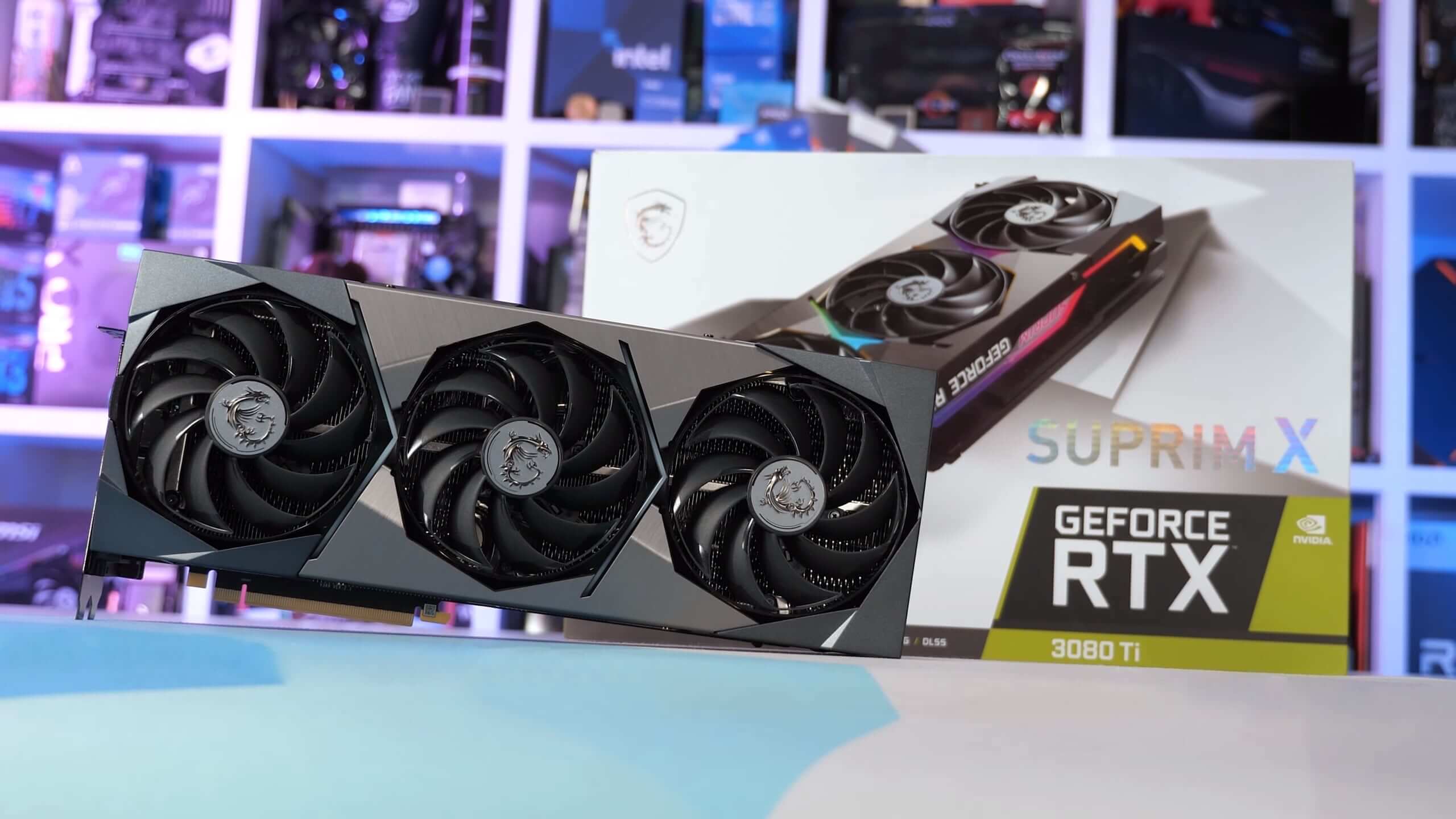
Despite the massive dimensions, the results were less impressive as the card peaked at 78C, or a whopping 14C hotter than the TUF Gaming. It was a bit quieter though, as the fans spun at just 1600 RPM. The cores also clocked at 1875 MHz which is a mere 2.5% increase over the TUF Gaming. Overall not a bad result, it’s just not particularly impressive given the weight and dimensions.
Overclocking
Here’s a look at how the cards performed in Shadow of the Tomb Raider at 1440p, both stock and overclocked. We were only able to squeeze 4% more out of the Founders Edition card, hitting 1885 MHz with the memory at 21 Gbps. The TUF Gaming was 1% faster out of the box and I was able to squeeze a further 3% from it, hitting 178 fps on average with a core frequency of 1900 MHz.
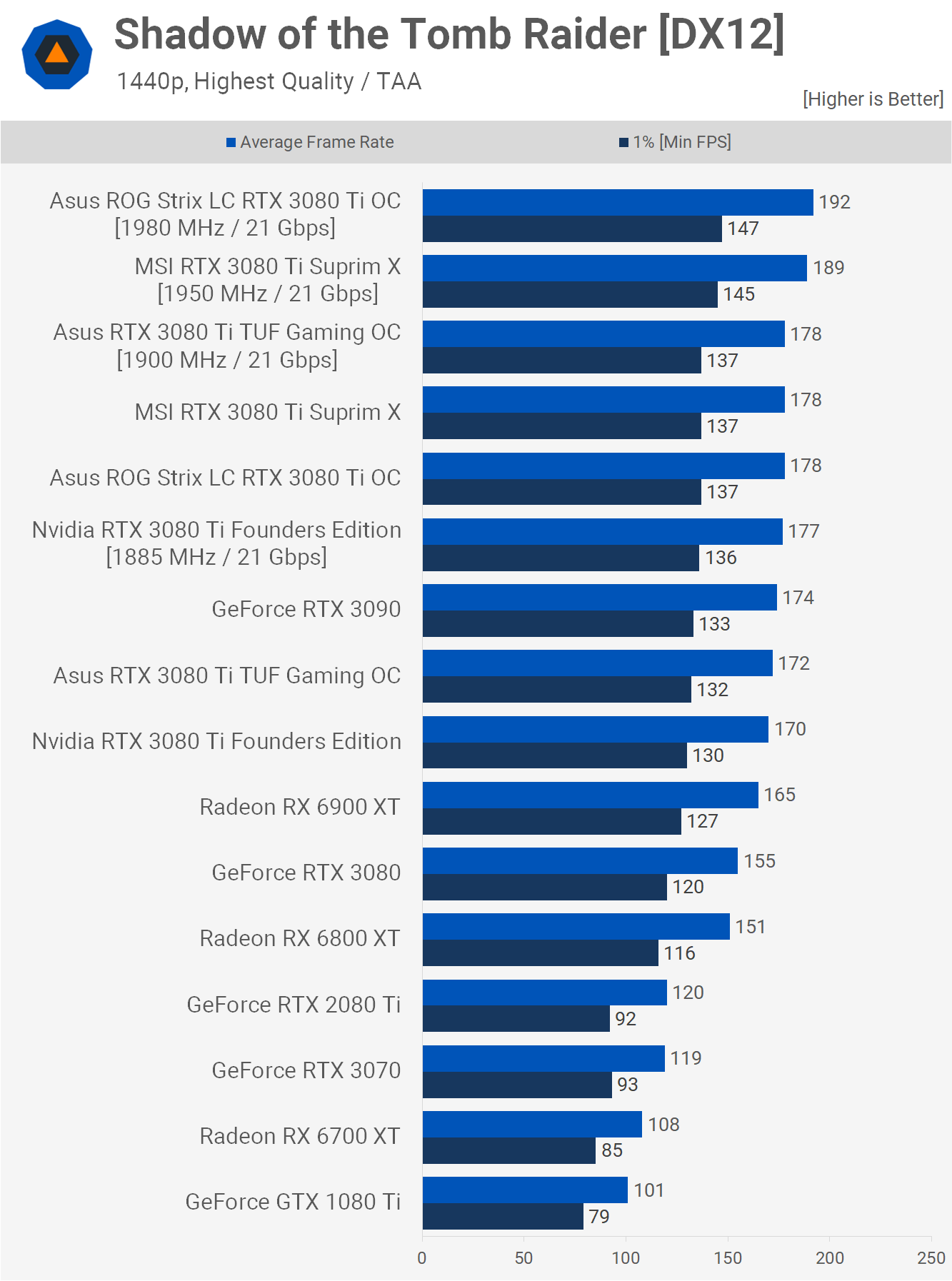
The liquid-cooled Asus ROG Strix LC was the most impressive, managing 178 fps out of the box and with the 1980 MHz overclock went up to 192 fps, so that’s an additional 8% performance making it 13% faster than a stock RTX 3080 Ti. Not exactly amazing stuff, but that’s GPU overclocking these days.
The Suprim X was also able to match the ROG Strix LC out of the box, though it did fall short when overclocked, but this will come down to silicon quality, so don’t read too much into the overclocking results.
Not for Gamers
The ‘new’ GeForce RTX 3080 Ti is essentially an RTX 3090 with half the VRAM. Normally, this could be considered good news since it’s cheaper at $1,920, but actual street pricing remains to be seen.
Some things have not changed… the RTX 3080 Ti is impressively fast, it’s technically an excellent product, and the extra 2GB of VRAM is welcome. But at $1,920 and with the current stock issues, it’s a poorly-timed release that frankly makes no sense, at least from a gamers perspective, it changes nothing.
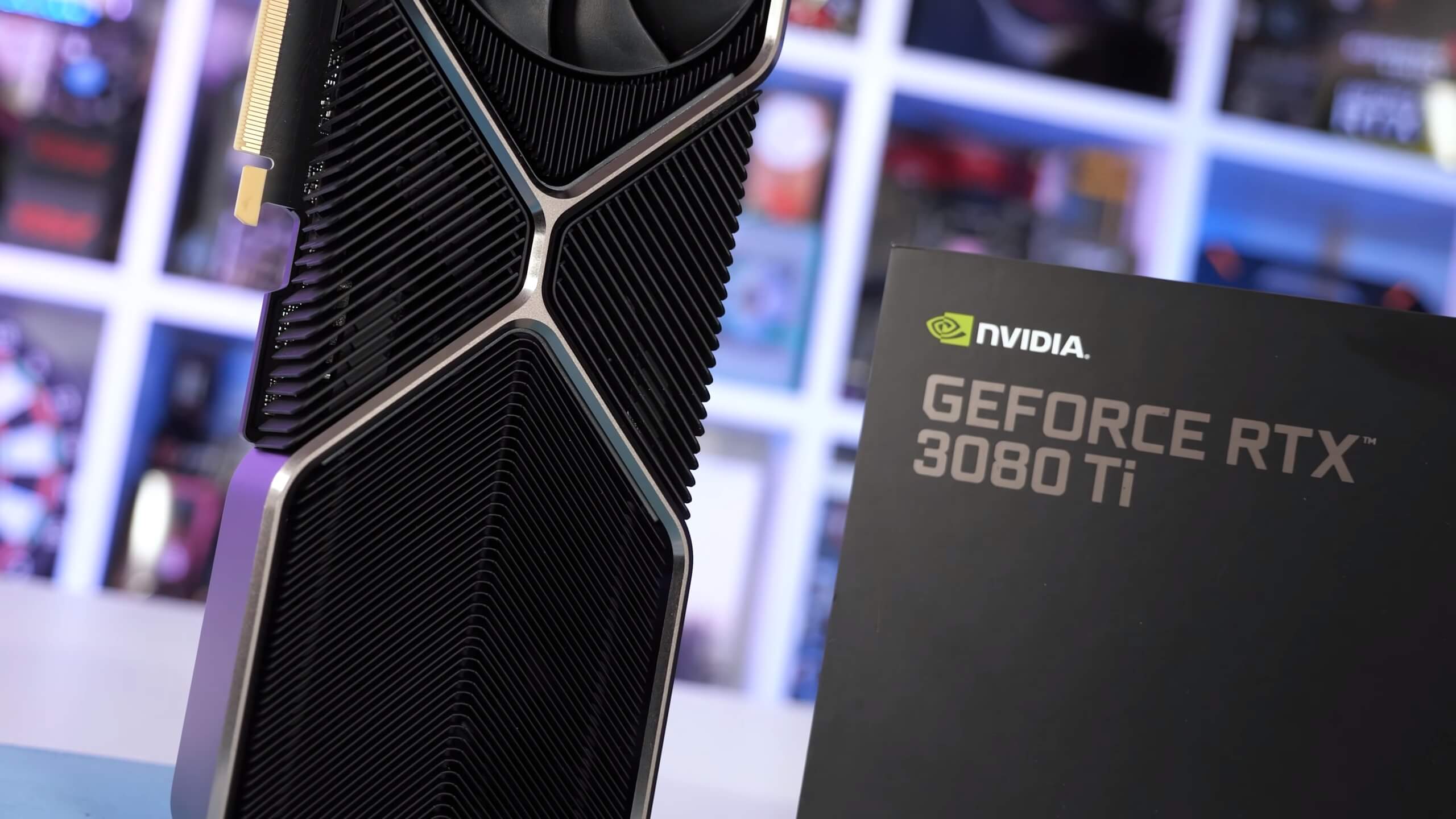
For a refresh, this sort of launch is to be expected, too. But the reason we don’t warmly welcome it is that Nvidia hasn’t finished releasing Ampere, with no affordable models on offer. After all, they talk about trying to help gamers with hardware limiters for mining, then turn around and release the RTX 3080 Ti, it’s honestly tone-deaf, but it is what the market dictates as far as demand goes and how they can continue to maximise returns.
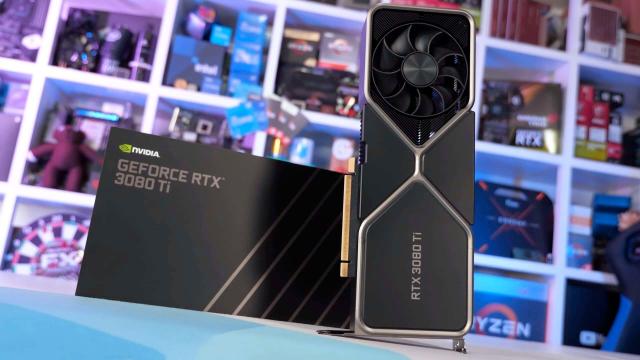
Leave a Reply